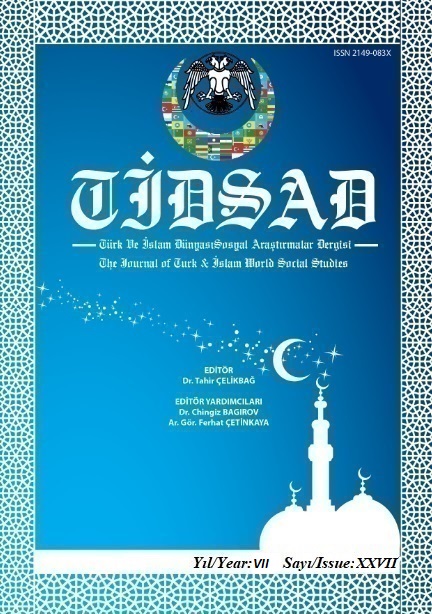Author :
Abstract
Sosyal bir varlık olan dil, içerdiği sözlü verilerle doğrudan iletişimde önemli bir yere sahiptir. İçinde bulunduğumuz interaktif ve dijital dünyada, biçimsel standartlar ve dilbilgisi kuralları sosyal hayatta konuşulan İngilizceye uyarlanmaya çalışılmıştır. Konuşmayla ilgili söz edimi, bilgi akışı, konu, bütünlük gibi alt başlıklarda çok sayıda kaynak olmasına rağmen konuşmanın ayırt edici gramer özelliklerine dair yeterince çalışma mevcut değildir.Bu çalışmada, konuşmada genellikle yaygın olan ve yazılı dilden farklı ve standart İngilizce olarak kabul edilen gramer özelliklerine odaklanılmaktadır. Örneğin, konuşma gerçek zamanlı olarak gerçekleşir, paylaşılan bir bağlamda gerçekleşir ve bu nedenle anlamın detaylandırılmasını önler. Ayrıca konuşma etkileşimlidir ve katılımcılar kendi duygu ve tutumları hakkında bir dizi ifade kullanarak konuşur. Duraklamalar, tereddütler, tekrarlar, eksik cümleler, yanlış başlangıçlar, boşluklar, nedensel olmayan sorular ve vokaller gibi konuşma akışını bozan istemsizlikler, doğrudan konuşmanın gerçek zamanıyla ilgilidir. Hem yapısal hem de kullanım perspektifleriyle pragmatik ve korpus tabanlı yaklaşımdan faydalanılan çalışma yukarıda sıralanan unsurlarla sınırlı olacaktır.
Keywords
Abstract
As a social entity, language has an important place in direct communication with the verbal data it contains. In the interactive and digital world we are in, formal standards and grammar rules have been adapted to English spoken in social life. Although there are many sources in subheadings such as speech acts, information flow, topic, and integrity, there are not enough studies on the distinctive grammatical features of speech. This study focuses on grammatical features that are generally common in speech and are different from the written language and accepted as standard English. For example, conversation takes place in real time, takes place in a shared context and therefore prevents elaboration of meaning. Moreover, the conversation is interactive and the participants talk about their own feelings and attitudes using a series of statements. Dysfluencies that disrupt the flow of speech, such as pauses, hesitations, repetitions, incomplete sentences, false starts, gaps, non-causal questions, and vocals, are directly related to the real time of speech. The study employing a pragmatic and corpus-based approach with both structural and usage perspectives will be limited to the elements mentioned above.
Keywords
- Brazil, D. (1995). A grammar of speech, Oxford University Press, Oxford.
- Biber, D. and et al. (1999). Longman grammar of spoken and written English, Pearson Education Limited, Harlow.
- Carter, R. and McCarthy, M. (1995). “Grammar and the spoken language”, Applied Linguistics 16 (2): 141–158.
- Carter, R. and McCarthy, M. (1997). Exploring Spoken English. Cambridge University Press, England. https://dictionary.cambridge.org/tr/s%C3%B6zl%C3%BCk/ingilizce/conversation
- Carter, R. and McCarthy, M. J. (2006). Cambridge grammar of English. Cambridge University Press, Cambridge, UK.
- Celce-Murcia, M. et al. (1995). “Communicative competence: a pedagogically motivated model with content specifications”, Linguistics, 6 (2), 5-29.
- Cornbleet, S. and Carter, R. (2001). The Language of Speech and Writing, Routledge, London.
- Cullen, R. and I. Kuo. (2007). “Spoken grammar and ELT course materials: A missing link?”, TESOL Quarterly, 41 (2): 361–386.
- Jones, C. (2018). Practice in Second Language Learning, Cambridge University Press, UK.
- Leech, G. (1983). Principles of pragmatics. Longman, London.
- Leech, G. (2000). “Grammars of Spoken English: New Outcomes of Corpus-Oriented Research English Language and Linguistics”, Language Learning, 50:4, 675–724
- McCarthy, M. and R, Carter. (1995). “Spoken grammar: What is it and how can we teach it?”, ELT Journal, 49 (3): 207–218.
- Mumford, S. (2009). “An analysis of spoken grammar: The case for production”, ELT Journal, 6Leech3 (2): 137–144.
- Quaglio, P. and Biber, D. (2006). “The Grammar of Conversation”, The Handbook of English Linguistics (eds B. Aarts and A. McMahon).
- Quirk, R. and et al. (1985). A comprehensive grammar of the English language, Longman London.
- Tannen, D. (1989). Talking voices: repetition, dialogue, and imagery in conversational discourse, Cambridge University Press.





